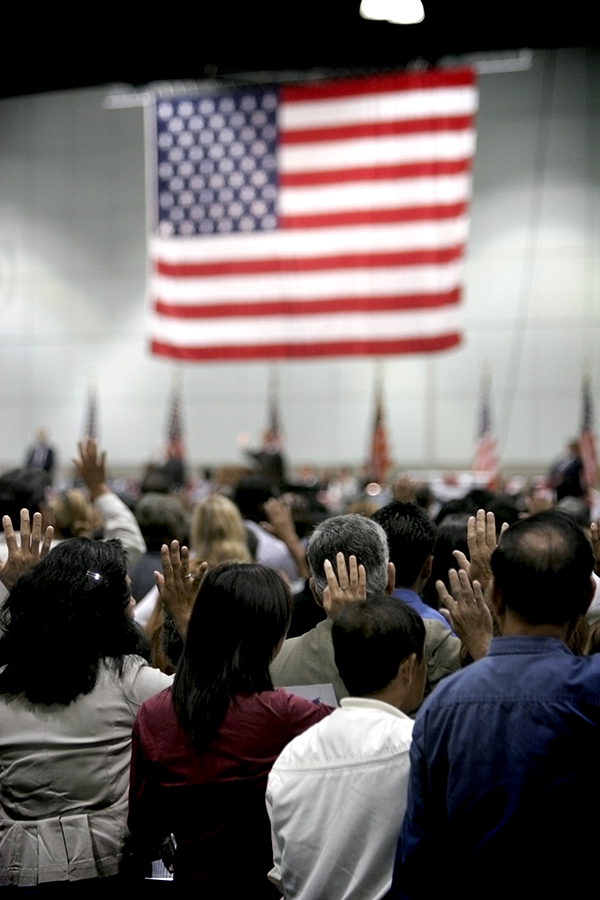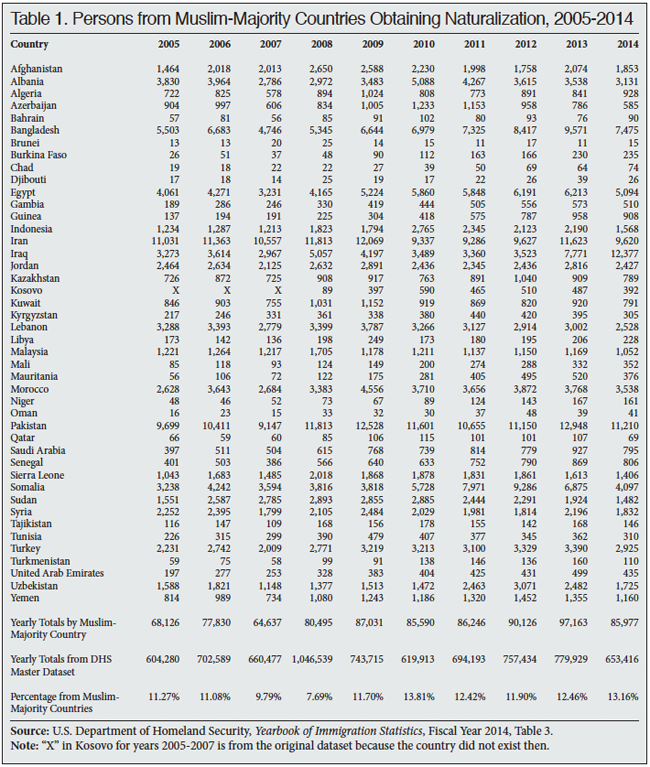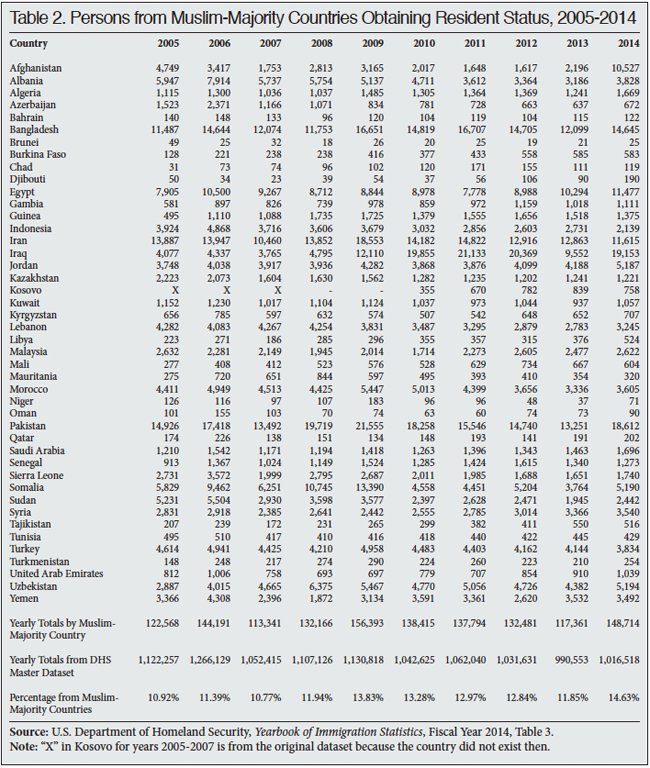Download a PDF of this Backgrounder.
Dan Cadman is a fellow at the Center for Immigration Studies.

The online magazine Vice.com recently posted an article in which some Muslims seeking naturalization allege that federal officials at United States Citizenship and Immigration Services (USCIS) are exhibiting bias by holding back on approvals.1 Exhibit "A" in the article was the case of one Mohammad al Muttan, who has apparently experienced delays that he attributes to this bias.
His case would seem to be undercut by his own words, because he points out that his "mother, brothers, uncle, wife, and four children [are] already citizens", leaving one to suspect that this isolated treatment has more to do with him, singularly, than Muslims in general. Be that as it may, he and several others have now filed suit alleging discrimination based on a security protocol underlying the vetting of applications called CARRP (Controlled Application Review and Resolution Program).2
This is the dilemma for officials at USCIS (about whom readers familiar with this author's work will know I'm not always sympathetic): Give away benefits willy-nilly and national security suffers. We've seen evidence of this again and again in the multiple arrests of aliens and naturalized citizens for terrorism- and espionage-related offenses in recent years. The Tsarnaev brothers and Tashfeen Malik, of Boston and San Bernardino infamy, respectively, are only two examples of flawed or indifferent vetting and approvals. On the other hand, hold benefits back in an attempt to stem the tide in the least little bit, and someone is inevitably filing suit alleging bias or abuse of discretion.
Louis D. (Don) Crocetti, who formed and led the Fraud Detection and National Security Unit (FDNSU) at USCIS in the early days following the agency's formation — and who was instrumental in bringing order out of chaos through such protocols as CARRP — has written a spirited defense of vetting procedures, including specifically CARRP, on Facebook that rejects out of hand the notion that anyone is, or has been, singled out simply for being Muslim.3
Because 13 plaintiffs in a lawsuit don't, at least in this author's estimation, make a persuasive case of pervasive bias against Muslims in any immigration benefit, including naturalization, I decided to do some rough calculations using statistics, which these days are so often used as evidence of discrimination, to see what they would tell us. It must be said straight out that the government steadfastly (and rightly) avoids statistics involving religion. For immigration officers, asking about one's religion is a forbidden question, except in the context of persons who claim it as a basis for persecution, and even then it is not tallied statistically. Despite this limitation, one can get a fair approximation, even though the methodology isn't particularly sophisticated.
First, we take the statistical data found in the 2014 Department of Homeland Security (DHS) Yearbook of Immigration Statistics, which includes a breakdown of naturalizations by country going back to 2005: 10 years of data.4 We next eliminate all countries except those that are majority Muslim to determine the numbers.5 We then compare these to the original dataset to calculate what percentage of naturalizations came from these majority-Muslim countries for each of the 10 years of data.
Statisticians and demographers will probably immediately point out that just because a naturalized citizen came from a majority-Muslim country doesn't mean that he or she is, in fact, Muslim. That is undoubtedly true, but it is worth observing that many Muslim-majority countries are so predominantly Islamic as to render people practicing other religions within their borders as statistical outliers. Think Saudi Arabia and the Gulf States; think Arab North Africa; think Iran and Iraq; think of the Central Asian republics (Uzbekistan, Tajikistan, etc.), for example.
On the flip side, though, and more significant by far, this methodology eliminates whole countries, large and small, that are not majority-Muslim, but which nonetheless have sizable Muslim populations. In doing so, we have almost certainly underrepresented the number of Muslims who naturalized because of those sizable Muslim populations, which may even be over-represented statistically in certain immigration categories (specifically, asylees and refugees), and therefore ultimately in naturalizations. This is because, to take only two examples, Muslims have a near-ready-made case for fear of persecution if they hail from the Caucasus regions of Russia or the former U.S.S.R., or from the predominantly-Muslim western provinces of China.
What is more, there are an abundance of countries with substantial, or even plurality, Muslim populations that were struck from the dataset using this winnowing technique. To name just a few instances:
- Benin (24.4 percent Muslim),
- Nigeria (50 percent Muslim, but not 51 percent, and therefore excluded from the table),
- Eritrea (33 to 50 percent Muslim),6
- Ethiopia (33.9 percent Muslim),
- Macedonia (33.3 percent Muslim), and
- Israel (17.5 percent Muslim, due to its native-born citizens of Palestinian heritage).
Even European nations now have significant Muslim populations: Britain (4.5 percent Muslim), France (9.6 percent Muslim), and Germany (4.3 percent Muslim, pre-Syrian migrant crisis, which has added to that figure substantially) are prime examples; all were stricken for purposes of this calculation.
India, the second-most populous country in the world (China is first), is another example: Over 14 percent of its population is estimated to be Muslim. With an overall population of slightly more than 1.25 billion people,7 that gives us a Muslim sub-population in excess of 175 million. It's beyond dispute that many Indian Muslims have migrated to the United States and become citizens. The same is true of the Philippines (14 percent Muslim, with an overall population exceeding 102 million). Thus, if even a modest portion of Indian or Filipino Muslims migrated to the United States, they undoubtedly exceeded the entire population of some of the majority-Muslim nations that were used in my estimations (such as Bahrain, Djibouti, and Oman, to name just three). But all of this data was stricken in the interest of being cautious in estimation.
Yet even with this radical elimination of significant Muslim populations, when we tally the final set of figures (which almost certainly undercounts by a significant amount the number of Muslims naturalized in the last 10 years), and compare it to the master dataset from DHS that encompasses all countries and all naturalizations, we find that there has been an incremental and significant rise in both numbers, from 68,126 in 2005 up to 85,977 in 2014, and percentages of naturalizations by aliens from majority Muslim countries, from 11.27 percent of the all-countries total in 2005, up to 13.16 percent in 2014. See Table 1.

When considering the figures in Table 1, the context of the time frame is of great import. USCIS and the Department of Homeland Security didn't even come into being until 2003, a year after passage of the Homeland Security Act. When USCIS was formed, it had no FDNSU up and running, and there was no CARRP system. The unit was created and evolved over time; protocols for vetting had to be conceptualized and promulgated; and the automated system had to be developed from scratch, tested, refined, and implemented nationally. In bureaucratic terms, such things don't happen over night, they take place over a span of years.
For these reasons, one might expect that if there were institutionalized discrimination against Muslims because of, or reinforced by, FDNSU or CARRP as alleged, then the numbers and percentages of Muslim naturalizations would have gone down between 2005 and 2014, the years after FDNSU was established and reached maturity, after operating procedures were standardized and after electronic vetting systems became fully operational.
Yet this is clearly not the case, as is evident by the rising numbers and percentages, which would undoubtedly be significantly higher if one were able to quantify with any precision the naturalization of Muslims from countries whose Muslim populations are substantial, but less than a majority.
It is also worth examining the numbers and percentages of aliens from majority-Muslim countries who obtained legal permanent resident status in the same period of time. Those, too, might be expected to show a decline, if bias were being exercised, given that FDNSU and CARRP play substantially the same role in the process used to vet aliens before they are approved for resident status.8
To determine those figures, we use exactly the same methodology as was used previously for naturalizations. This data can also be found in the DHS 2014 Yearbook of Immigration Statistics.9 Table 2 reports the results from that examination.

Once again, we find no diminution either in the number of individuals from majority-Muslim countries who obtained legal resident status in the years between 2005 and 2014, or in the percentage of the persons obtaining residency, when compared with the overall population of aliens given resident status.
To the contrary, as with the naturalizations previously examined for that same period, there has been significant growth in both numbers (from 122,568 in 2005 up to 148,714 in 2014) and percentages (from 10.92 percent in 2005, up to 14.63 percent in 2014) of aliens from majority-Muslim countries receiving lawful resident status in the United States during the 10-year period. What's more, the average percentage over the 10-year period was 12.44 percent, similar to the 10-year average for naturalization of 11.53 percent. Although grants of legal residency and naturalization are different things (as explained in end note 8), the similarity in the rates again argues against any bias in granting citizenship to Muslims.
A few other factoids relevant to the inquiry:
- An additional examination of the statistics for majority-Muslim countries from 2000 to 2004 (derived using the same methodology discussed above, from the DHS Yearbook for 2009)10 when collated with data from the prior tables, shows that in the 15 years between 2000 through 2014, yearly naturalization of individuals from those countries increased substantially, from 73,391 in 2000 to 85,977 in 2014. Note that these two figures represent neither the lowest year of naturalizations (52,455 in 2003) nor the highest year (97,163 in 2013).
- Similarly, an examination of the resident alien statistics for majority-Muslim countries for 2000 through 2009 shows that, when collated with the prior statistical data, for the 15 years between 2000 and 2014, procurement of permanent residence by individuals from Muslim-majority countries increased exponentially, from 82,040 in 2000 to 148,714 in 2014.11
Finally, it is worth noting in passing that, by comparison with these percentages, the Pew Research Center estimates that Muslims make up only 1 percent of the population of the United States, although Pew calculates that this will double by 2050.12 The figures derived from DHS statistics would certainly appear to substantiate that estimation.
In sum, if there is either a systemic or systematic bias against Muslim applicants for either naturalization, as alleged in the lawsuit, or for lawful resident alien status, the statistics don't show it; rather, they show a robust and sustained increase in both residency and naturalization of aliens from majority-Muslim nations.
End Notes
1 Meredith Hoffman, "Muslims Applying for US Citizenship Say the Feds Are Delaying Their Applications", Vice, May 23, 2016.
2 A brief description of CARRP can be found online at the official USCIS website.
3 Full disclosure: Don Crocetti is a friend and former colleague of the author from INS days. Crocetti's remarks are worth reading (they have been reproduced with his permission). See also a wide-ranging video interview with Crocetti on the issue of immigration fraud.
4 U.S. Department of Homeland Security, Office of Immigration Statistics, Yearbook of Immigration Statistics, Fiscal Year 2014, Table 21, "Persons Obtaining Naturalization by Region and Country of Birth: Fiscal Years 2005 to 2014".
5 The Central Intelligence Agency's World Factbook was used as the source to determine which countries from the original DHS dataset constitute "majority-Muslim" nations. This may be accomplished by selecting the country from the drop-down list, choosing the "People and Society" topic for that nation, and then scrolling down to the "Religions" subtopic.
6 The World Factbook does not break down religious percentages for Eritrea; the figures in this instance were derived from Eritrea's official website, which estimates one-third of the population as Muslim; and the "Muslim Population in the Word" website, which caveats its assessment, but states, "No reliable figures on religious affiliation are available, but approximately half of the Eritrean population is Sunni Muslim."
7 The overall population of India was calculated as of July 2015, according to the World Factbook.
8 A word about naturalization and procurement of permanent residency: There is not, and cannot be, anywhere near a one-to-one equivalency between the numbers. There are many reasons for this, but two prime reasons are 1) because the statutory times one is required to be a resident alien before applying for naturalization vary, depending on how one obtained resident status; and 2) there is no legal requirement that resident aliens ever apply for naturalization. This latter is extremely important to keep in mind. Many aliens are content to live and work permanently in the United States without taking the final act of seeking citizenship.
9 U.S. Department of Homeland Security, Office of Immigration Statistics, Yearbook of Immigration Statistics, Fiscal Year 2014, Table 3, "Persons Obtaining Lawful Permanent Resident Status by Region and Country of Birth: Fiscal Years 2005 to 2014".
10 U.S. Department of Homeland Security, Office of Immigration Statistics, Yearbook of Immigration Statistics, Fiscal Year 2009, Chapter 21, "Persons Naturalized by Region and Country of Birth: Fiscal Years 2000 to 2009".
11 Ibid., Chapter 3, "Persons Obtaining Legal Permanent Resident Status by Region and Country of Birth: Fiscal Years 2000 to 2009".
12 Besheer Mohamed, "A new estimate of the U.S. Muslim population", Pew Research Center, Fact Tank News in the Numbers, January 6, 2016.
